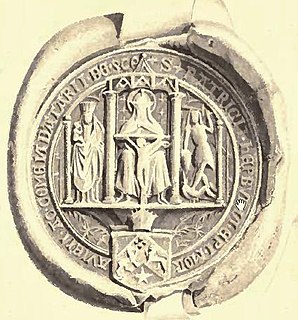
James Hepburn, 1st Duke of Orkney and 4th Earl of Bothwell, better known simply as Lord Bothwell, was a prominent Scottish nobleman. He was known for his marriage to Mary, Queen of Scots, as her third and final husband. He was accused of the murder of Mary's second husband, Henry Stuart, Lord Darnley, a charge of which he was acquitted. His marriage to Mary was controversial and divided the country; when he fled the growing rebellion to Norway he was arrested and lived the rest of his life imprisoned in Denmark.
Earl of Bothwell was a title that was created twice in the Peerage of Scotland. It was first created for Patrick Hepburn in 1488, and was forfeited in 1567. Subsequently, the earldom was re-created for the 4th Earl's nephew and heir of line, Francis Stewart, whose father was an illegitimate son of James V. The second creation was forfeited in 1612, and although the heir was subsequently rehabilitated, the title was never restored.
Hepburn is a family name of the Anglo-Scottish border, that is associated with a variety of famous personages, eponyms, places, and things. Although commonly a Scottish name, its origins lie to the south of the border in the north of England. Specifically, the name is thought to have derived from Hepburn or Hebron in Northumberland or Hebburn in Tyne and Wear. The origins of the name are suggested to be the same as that of Hebborne from the Old English words heah ("high") and byrgen. Alternatively it could mean something along the lines of "high place beside the water", as the word burn is a still widely used in Northumbrian and Scots for stream.

Hermitage Castle is a semi-ruined castle in the border region of Scotland. It is under the care of Historic Scotland. The castle has a reputation, both from its history and its appearance, as one of the most sinister and atmospheric castles in Scotland.
Patrick Hepburn, 1st Earl of Bothwell was Lord High Admiral of Scotland. He rose to political prominence after supporting James IV against his father, and was proxy at the King's marriage.
Adam Hepburn, 2nd Earl of Bothwell was a Scottish nobleman, who succeeded his father Patrick Hepburn, 1st Earl of Bothwell in 1508. Prior to that, he was known by one of his territorial designations, Adam Hepburn of Crags, under which he drew up his Testament.
Sir Adam Hepburn was the son of Adam Hepburn, Master of Hailes and Helen Home, and brother of Patrick, the first Earl of Bothwell. He lived at Craigs, Kirkcudbrightshire, Scotland.
John Hepburn was a Scottish cleric. The son of Patrick Hepburn, 1st Lord of Hailes, he was Prior of Saint Andrews. He established St. Leonard's College at the University of St. Andrews in 1512. In around 1520 he funded the reconstruction of the town walls of St. Andrews.
Bothwell is a town in Scotland.
Sir Robert Lauder of Popill was a Scottish landowner and an adherent of Mary, Queen of Scots.
James Hepburn may refer to:

Patrick Hepburn was a 16th-century Scottish prelate. He served as both pre- and post-Reformation Bishop of Moray.

Jean Hepburn, Lady Darnley, Mistress of Caithness, Lady Morham was a Scottish noblewoman and a member of the Border clan of Hepburn. Her brother was James Hepburn, Earl of Bothwell, the third husband of Mary, Queen of Scots. Jean's first husband was John Stewart, 1st Lord Darnley, an illegitimate half-brother of Queen Mary, which made Jean a double sister-in-law of the queen. Jean married three times. She was also Lady of Morham, having received in 1573 the barony of Morham and lands which had belonged to her mother, Lady Agnes Sinclair and was forfeited to the Crown subsequent to her brother, the Earl of Bothwell's attainder for treason.

John Hepburn was provided bishop of Brechin, Scotland, by Pope Leo X on 29 October 1516, but there may have been a delay in consecrating him due to his "defect of age". He may not have been consecrated until sometime between June 1522 and 23 February 1523, though the evidence is complex and contradictory.
Lady Agnes Stewart was a Scottish noble. She was born the illegitimate daughter of James Stewart, 1st Earl of Buchan and Margaret Murray. On 31 October 1552 she was legitimized, confirmed by Queen Mary of Guise under the Great Seal of Scotland.
George Hepburn may refer to:
Events from the year 1578 in the Kingdom of Scotland.

Henry Sinclair was a Scottish noble and the 4th Lord Sinclair. In The Scots Peerage by James Balfour Paul he is designated as the 3rd Lord Sinclair, but historian Roland Saint-Clair designates him the 4th Lord Sinclair and references this to an Act of the Scottish Parliament in which he was made Lord Sinclair based on his descent from his great-grandfather, Henry II Sinclair, Earl of Orkney, the first Lord Sinclair. Bernard Burke, in his a Genealogical and Heraldic Dictionary of the Peerage and Baronetage of the British Empire, agrees with Roland Saint-Clair and says that Henry Sinclair was "in reality" the fourth holder of the title of Lord Sinclair.
Admiral Hepburn may refer to:




